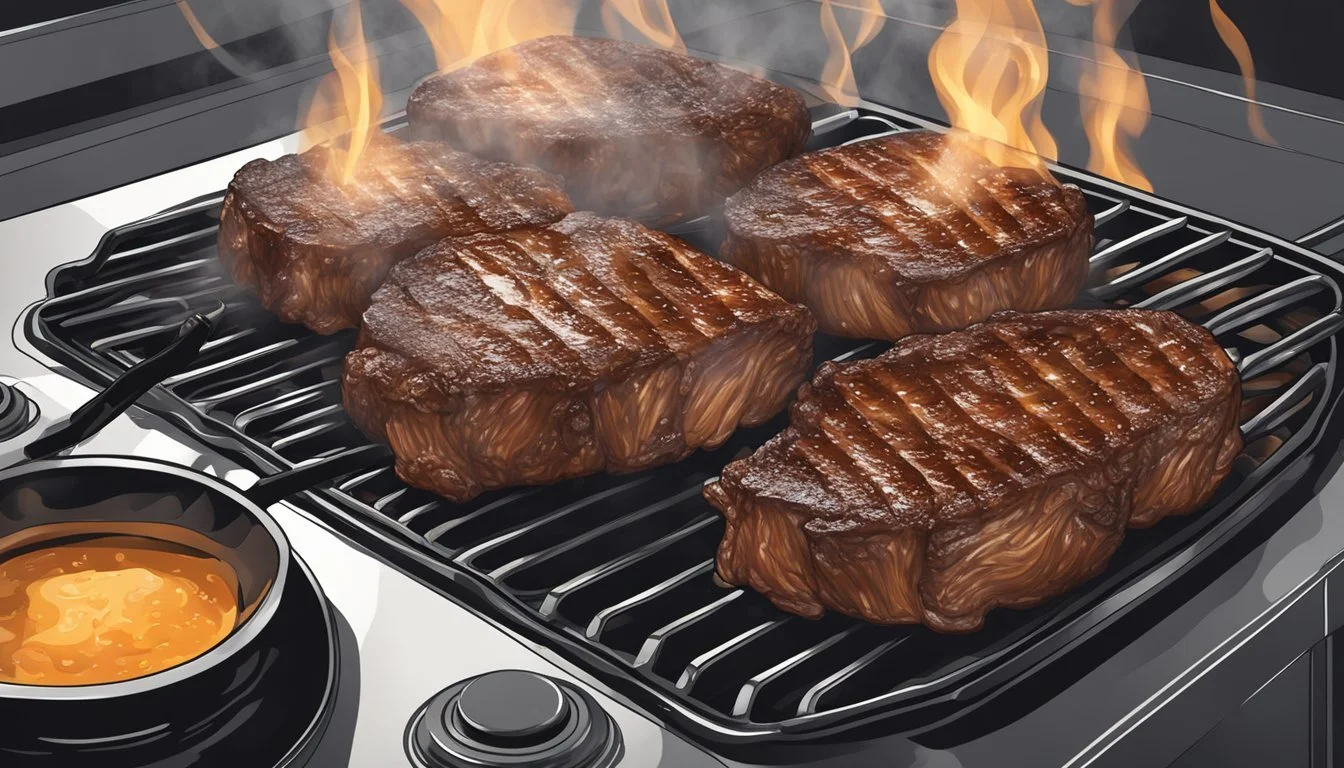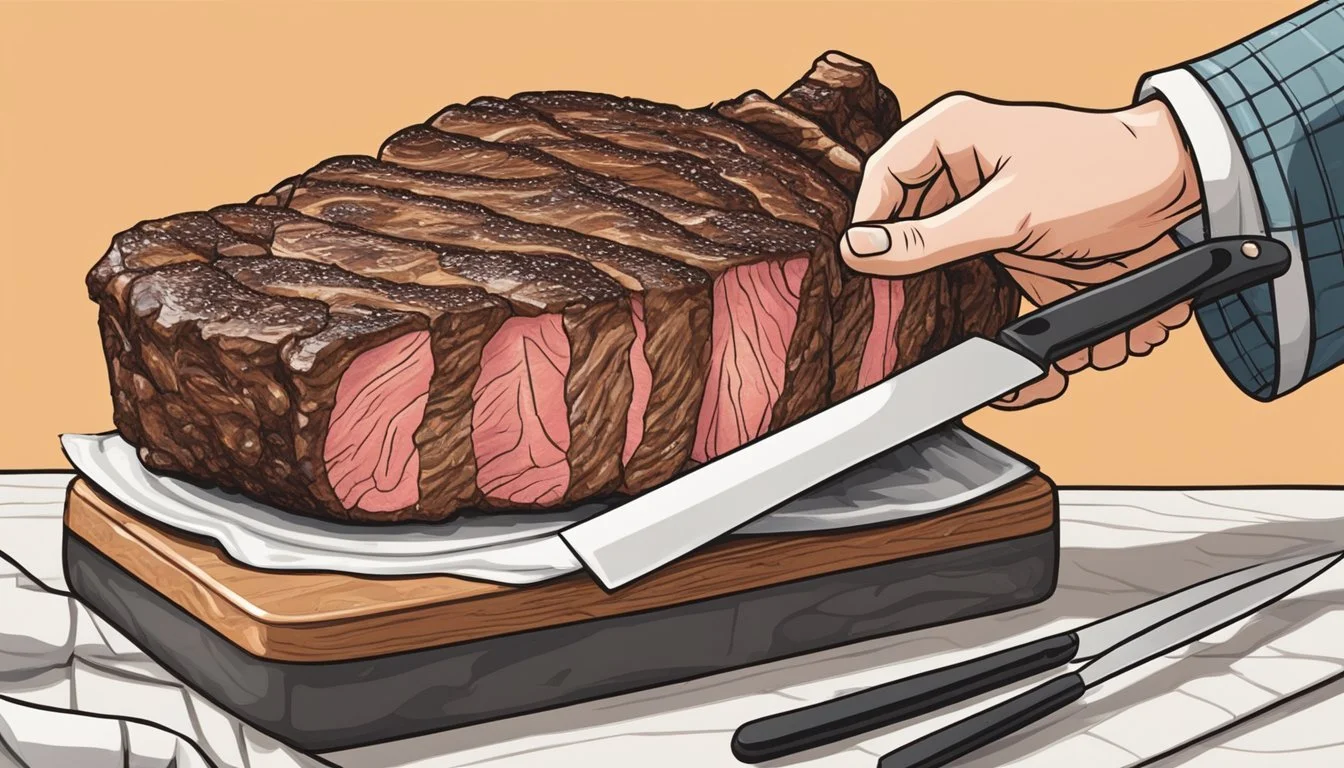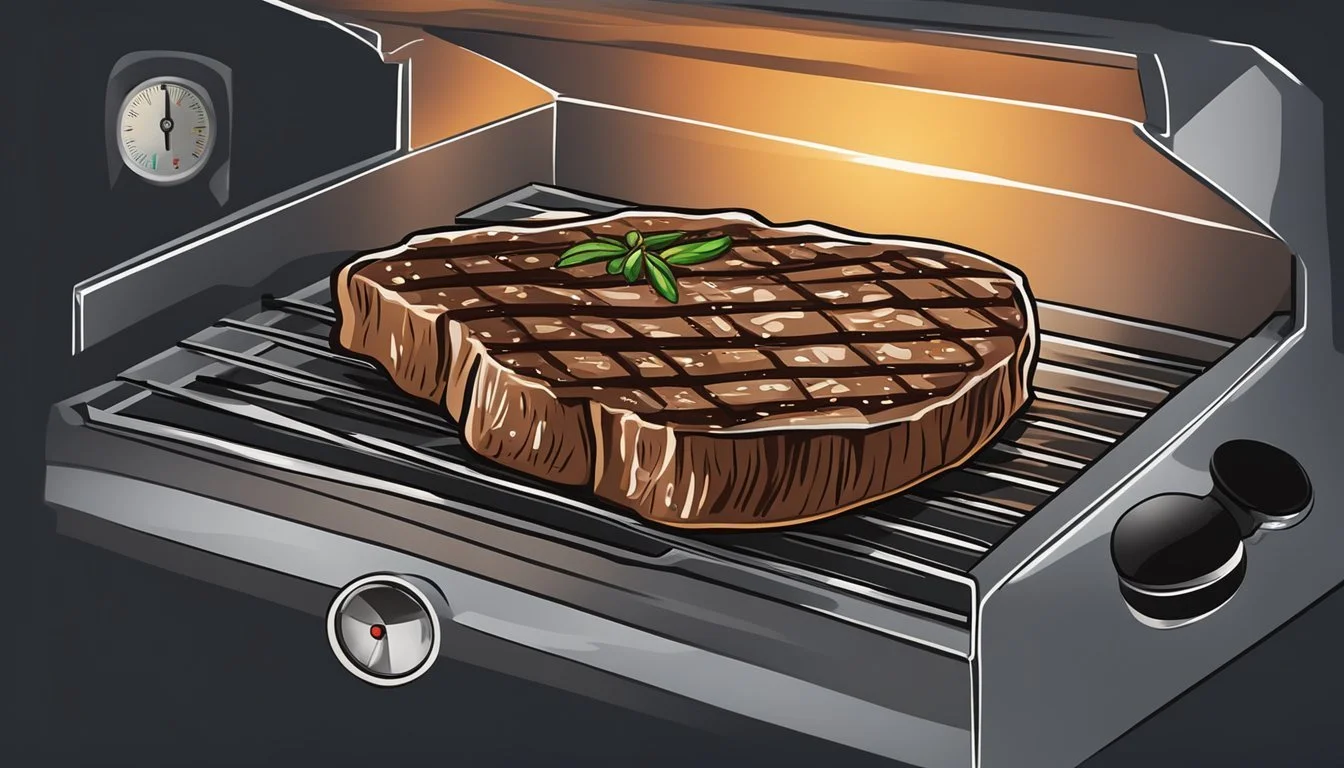How to Cook a Perfect 3/4 Inch Ribeye Steak
Tips and Techniques
Cooking a 3/4 inch ribeye steak to perfection requires attention to detail and proper technique. This flavorful cut of beef deserves special care to bring out its rich taste and tender texture. The key to a delicious ribeye is searing it over high heat for 2-3 minutes per side to develop a golden-brown crust, then finishing it to your desired doneness.
Seasoning plays a crucial role in enhancing the natural flavors of the ribeye. A simple blend of salt, black pepper, and optional herbs or spices can elevate the steak's taste profile. Some chefs recommend salting the steak 40 minutes before cooking to allow the seasoning to penetrate the meat.
For optimal results, start with a room temperature steak and a preheated cooking surface. Whether using a cast iron skillet or grill, ensure it's hot enough to create that coveted sear. With the right preparation and cooking method, even home cooks can achieve restaurant-quality results with a 3/4 inch ribeye steak.
Selecting the Perfect Ribeye
Choosing the right ribeye steak is crucial for a delicious meal. The cut, marbling, and thickness all play important roles in the final result.
Bone-In vs. Boneless
Ribeye steaks come in two main varieties: bone-in and boneless. Bone-in ribeyes offer a more intense flavor due to the marrow in the bone. They also tend to be juicier and can help prevent overcooking.
Boneless ribeyes are easier to cook evenly and offer more meat per pound. They're also simpler to slice and eat. The choice between bone-in and boneless often comes down to personal preference.
Some chefs believe the bone adds flavor during cooking, while others argue the difference is minimal. Ultimately, both options can produce excellent results when cooked properly.
Understanding Marbling
Marbling refers to the white streaks of fat within the meat. Higher marbling generally indicates a more flavorful and tender steak. Look for steaks with even, fine lines of fat throughout the muscle.
USDA grades can help identify marbling levels:
Prime: Highest marbling, most tender
Choice: Good marbling, very flavorful
Select: Leaner, less marbling
For the best ribeye experience, aim for Prime or high Choice grades. These offer the rich, beefy flavor and tenderness ribeyes are known for.
Thickness and Size
The ideal thickness for a ribeye steak is typically between 1 to 1.5 inches. This allows for proper searing while maintaining a juicy interior. Thinner steaks can easily overcook, while thicker cuts may require different cooking methods.
For a 3/4 inch ribeye, cooking times will be shorter. These thinner cuts are best suited for quick, high-heat cooking methods like pan-searing or grilling.
Size-wise, a 10-12 oz ribeye is generally suitable for one person. Larger cuts can be shared or saved for leftovers. Remember that the steak will shrink slightly during cooking.
Preparation Basics
Proper preparation is crucial for cooking a delicious 3/4 inch ribeye steak. Two key steps ensure optimal flavor and texture.
Bringing to Room Temperature
Remove the ribeye from the refrigerator 30-45 minutes before cooking. This allows for more even cooking throughout the steak. Place it on a clean plate or board on the kitchen counter.
As the steak warms up, its muscle fibers relax, leading to a more tender result. Room temperature steaks also cook faster and more evenly than cold ones. This step helps prevent overcooking the outside while leaving the center undercooked.
Seasoning Your Steak
Season the ribeye generously just before cooking. Use kosher salt and freshly ground black pepper for a classic flavor profile. Sprinkle salt evenly over both sides of the steak, using about 1 teaspoon per pound of meat.
Add black pepper to taste. For extra flavor, consider using a pre-made steak seasoning blend. Rub the seasonings into the meat gently. Allow the seasoned steak to rest for 5-10 minutes before cooking.
This short resting period allows the salt to penetrate the meat, enhancing flavor and promoting a better crust during cooking.
Cooking Techniques
Mastering different cooking techniques is key to achieving the perfect ribeye. Each method offers unique benefits for developing flavor and texture.
Grilling The Ribeye
Grilling imparts a smoky flavor and creates appetizing grill marks. Preheat the grill to high heat, around 450-500°F. Pat the ribeye dry and season generously with salt and pepper.
Place the steak on the hot grates. Grill for 3-4 minutes per side for medium-rare. Use tongs to flip, avoiding puncturing the meat.
For crosshatch marks, rotate the steak 45 degrees halfway through cooking each side. Let the ribeye rest for 5-10 minutes before serving to allow juices to redistribute.
Pan Searing in a Skillet
A cast iron skillet provides excellent heat retention for a perfect crust. Heat the skillet over medium-high heat until very hot. Add a high smoke point oil like canola or grapeseed.
Pat the ribeye dry and season. Place it in the hot skillet. Cook for 3-4 minutes per side for medium-rare, flipping only once.
Baste the steak with butter, garlic, and herbs in the last minute for added flavor. Let it rest before slicing against the grain.
The Reverse Sear Method
Reverse searing combines low temperature cooking with a high heat finish. Preheat the oven to 250°F. Place the seasoned ribeye on a wire rack over a baking sheet.
Cook until the internal temperature reaches 115°F for medium-rare, about 25-30 minutes. Remove and rest for 10 minutes.
Heat a skillet or grill to high heat. Sear the ribeye for 1-2 minutes per side to develop a crust. This method ensures even doneness and a great texture throughout.
Monitoring Doneness
Achieving the perfect doneness for a 3/4 inch ribeye requires careful monitoring. Accurate temperature measurement and tactile assessment are key techniques to ensure your steak reaches the desired level of cooking.
Using a Meat Thermometer
Insert a meat thermometer into the thickest part of the ribeye to check its internal temperature. For rare, aim for 125°F (52°C). Medium-rare is ideal at 135°F (57°C). Medium reaches 145°F (63°C), while well-done is 160°F (71°C) and above. Remove the steak 5°F below the target temperature, as it will continue cooking while resting. Digital instant-read thermometers provide quick, accurate readings. Clean the thermometer between uses to prevent cross-contamination.
Understanding the Feel of Doneness
The firmness of a steak changes as it cooks. A rare steak feels soft and spongy when pressed. Medium-rare offers slight resistance, comparable to the feel of the base of your thumb when touching your middle finger to it. Medium feels firmer, like the base of your thumb when touching your ring finger. Well-done is very firm, similar to the base of your thumb when your pinky touches it. Practice this technique alongside temperature readings to develop a reliable sense of doneness by touch.
Creating a Flavorful Crust
A flavorful crust elevates a ribeye steak from good to exceptional. Proper searing techniques and the right ingredients are key to developing a delicious exterior.
Basting with Butter
Start by heating a cast iron skillet over medium-high heat. Add a small amount of canola oil to prevent sticking. Once hot, place the 3/4 inch ribeye in the pan.
Sear for 2-3 minutes on each side to develop initial browning. Add butter to the pan and let it melt. Tilt the pan slightly and use a spoon to baste the steak with the melted butter.
This process helps create a rich, golden crust while infusing flavor. Continue basting for 1-2 minutes, flipping the steak once halfway through.
The butter will brown slightly, adding nutty notes to the crust. Be careful not to let it burn.
Herbs and Spices for Crust Enhancement
Fresh herbs and spices take the crust to the next level. Add crushed garlic cloves, sprigs of thyme, and rosemary to the pan while basting.
The aromatics will infuse the butter and coat the steak's surface. Press cracked black pepper into the meat before cooking for added texture and flavor.
For a Mediterranean twist, rub the steak with a mixture of dried oregano, garlic powder, and salt before searing. Alternatively, try a blend of smoked paprika and cumin for a smoky profile.
Experiment with different herb and spice combinations to find your perfect crust. Remember to pat the steak dry before seasoning to ensure proper adhesion and browning.
Resting and Serving
Proper resting and serving techniques are crucial for achieving a perfectly juicy and tender ribeye steak. These final steps can make or break your culinary creation.
Optimal Resting Time
After removing the ribeye from the grill, allow it to rest for 5-10 minutes. This resting period enables the juices to redistribute throughout the meat, resulting in a more flavorful and tender steak.
Place the steak on a warm plate or cutting board. Loosely cover it with aluminum foil to retain heat without trapping moisture. The internal temperature will continue to rise slightly during this time, so factor that into your desired doneness.
For thicker cuts, extend the resting time to 10-15 minutes. This ensures even distribution of juices throughout the steak.
Slicing and Presentation
Once rested, it's time to slice and serve your ribeye. Use a sharp knife to cut against the grain, which helps maintain tenderness.
For optimal presentation:
Slice the steak into 1/2-inch thick pieces
Arrange slices on a pre-warmed plate
Drizzle any accumulated juices over the meat
Consider garnishing with fresh herbs like rosemary or thyme for added visual appeal. Serve immediately to enjoy the steak at its best temperature and texture.
Pair your perfectly cooked ribeye with complementary sides like roasted vegetables or a crisp salad to complete the meal.
Accompaniments and Sides
A perfectly cooked ribeye steak deserves thoughtful side dishes and pairings to create a well-rounded meal. Complementary flavors and textures enhance the rich, juicy steak.
Vegetable Pairings
Grilled asparagus pairs wonderfully with ribeye. Brush spears with olive oil, season with salt and pepper, then grill for 3-5 minutes until tender-crisp. Roasted Brussels sprouts offer a nutty flavor that complements the steak's richness. Toss halved sprouts with olive oil and balsamic vinegar, then roast at 400°F for 20-25 minutes.
A fresh salad provides a crisp contrast. Try a simple arugula salad with lemon vinaigrette or a classic Caesar with homemade dressing. For a heartier option, consider a wedge salad with blue cheese crumbles and bacon bits.
Sautéed mushrooms make an excellent topping for ribeye. Use a mix of wild mushrooms like shiitake, oyster, and cremini for varied flavors and textures.
Potato Dishes
Crispy roasted potatoes are a classic steakhouse side. Cut red potatoes into wedges, toss with olive oil and rosemary, then roast at 425°F for 25-30 minutes. For a creamier option, prepare garlic mashed potatoes. Boil peeled Yukon Gold potatoes, then mash with butter, cream, and roasted garlic.
Twice-baked potatoes offer a decadent choice. Bake russet potatoes, scoop out the flesh, mix with cheese and chives, then refill and bake again until golden. For a lighter alternative, try hasselback potatoes. Thinly slice potatoes, brush with butter, and bake until crispy.
Wine and Sauce Pairings
Bold red wines complement ribeye's rich flavor. Cabernet Sauvignon, with its full body and tannins, pairs excellently. Malbec and Syrah are also good choices. For white wine lovers, a full-bodied Chardonnay can work well.
A classic béarnaise sauce enhances the steak's flavor. This butter-based sauce combines shallots, tarragon, and white wine vinegar. For a simpler option, mix softened butter with minced garlic and herbs to create a compound butter.
Red wine reduction sauce adds depth. Sauté shallots in the pan used to cook the steak, add red wine to deglaze, then reduce until syrupy. Finish with a pat of butter for richness.
Safety and Storage
Proper handling and storage of ribeye steaks is crucial for food safety and maintaining quality. Careful cooling, refrigeration, and reheating practices help preserve flavor and texture while preventing foodborne illness.
Proper Cooling and Refrigeration
Refrigerate cooked ribeye steaks within 2 hours of cooking, or within 1 hour if the temperature is above 90°F (32°C). Place steaks in shallow, airtight containers or wrap tightly in aluminum foil or plastic wrap. Store in the refrigerator at 40°F (4°C) or below for 3-4 days.
For longer storage, freeze ribeye steaks at 0°F (-18°C) or below. Wrap tightly in freezer paper or plastic wrap, then place in a freezer bag. Remove as much air as possible before sealing. Label with the date and use within 6-12 months for best quality.
When thawing frozen steaks, place them in the refrigerator overnight. Never thaw at room temperature, as this can promote bacterial growth.
Reheating Without Loss of Quality
To reheat ribeye steaks without drying them out, preheat the oven to 250°F (120°C). Place steaks on a wire rack set over a baking sheet. Heat until the internal temperature reaches 110°F (43°C), about 15-20 minutes for a 3/4-inch thick steak.
For a crisp exterior, finish by searing in a hot skillet for 1 minute per side. Alternatively, use the broiler for 1-2 minutes per side.
Avoid microwaving, as this can lead to uneven heating and toughen the meat. When reheating, consider adding a pat of butter or drizzle of olive oil to help retain moisture.
Always use a meat thermometer to ensure reheated steaks reach a safe internal temperature of 165°F (74°C) before consuming.










